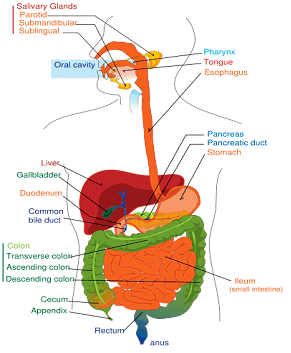
This is a diagram of the upper GI tract
Upper GI
GI stands for "gastrointestinal" tract. An upper GI (UGI) is an exam that looks at the upper portion of the digestive system. It includes the esophagus, stomach, and duodenum. It shows pathology such as Zenker's diverticuli, esophageal varices, cancer, fistulas, ulcers, etc.
The Exam
The exam is done by a radiologist and a radiology tech. The patient begins the exam standing on the footboard of the fluoro table. The radiologist has the patient drink a small amount of gas crystals dissolved in water (like an Alka-Seltzer) and the patient is instructed not to burp. The bubbles help expand the stomach and esophagus so that pathology can be seen. The patient is then given a cup of barium to drink. The radiologist then watches as the barium passes through the esophagus to the stomach. The table is then laid down and the patient is asked to roll in a circle which helps the barium coat the entire stomach. More pictures are then taken which includes most of the esophagus, the stomach and the duodenum.
Procedure Summary
●Patient Prep: Fasting after 10:00 pm the night before. No food, water, smoking, or gum.
●Medication Instructions: No stomach medications within 12 hours before the exam. (Benthine, Cremalin, Gelusil, Tagament, etc.)
●Exam Time: Approximately 30 minutes
●Post Exam Instructions: Drink lots of fluids, notify family physician if no bowel movement within three days, if this is abnormal.

